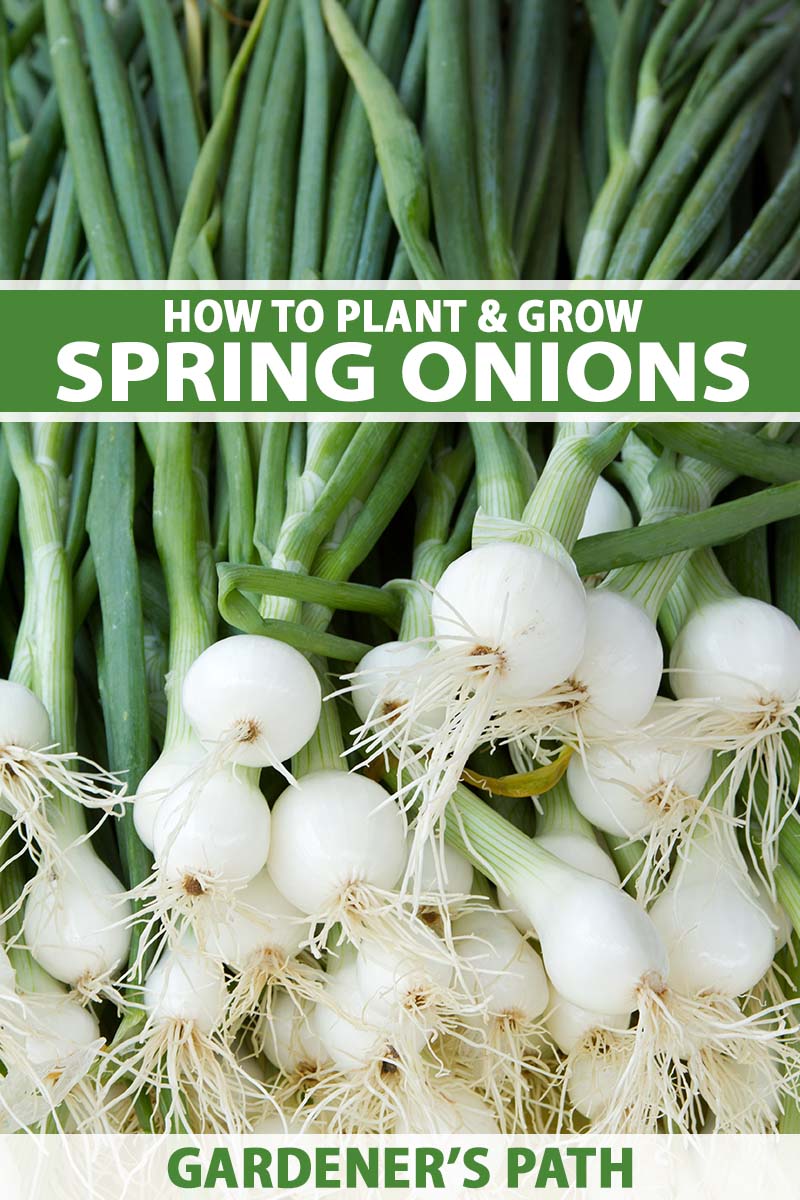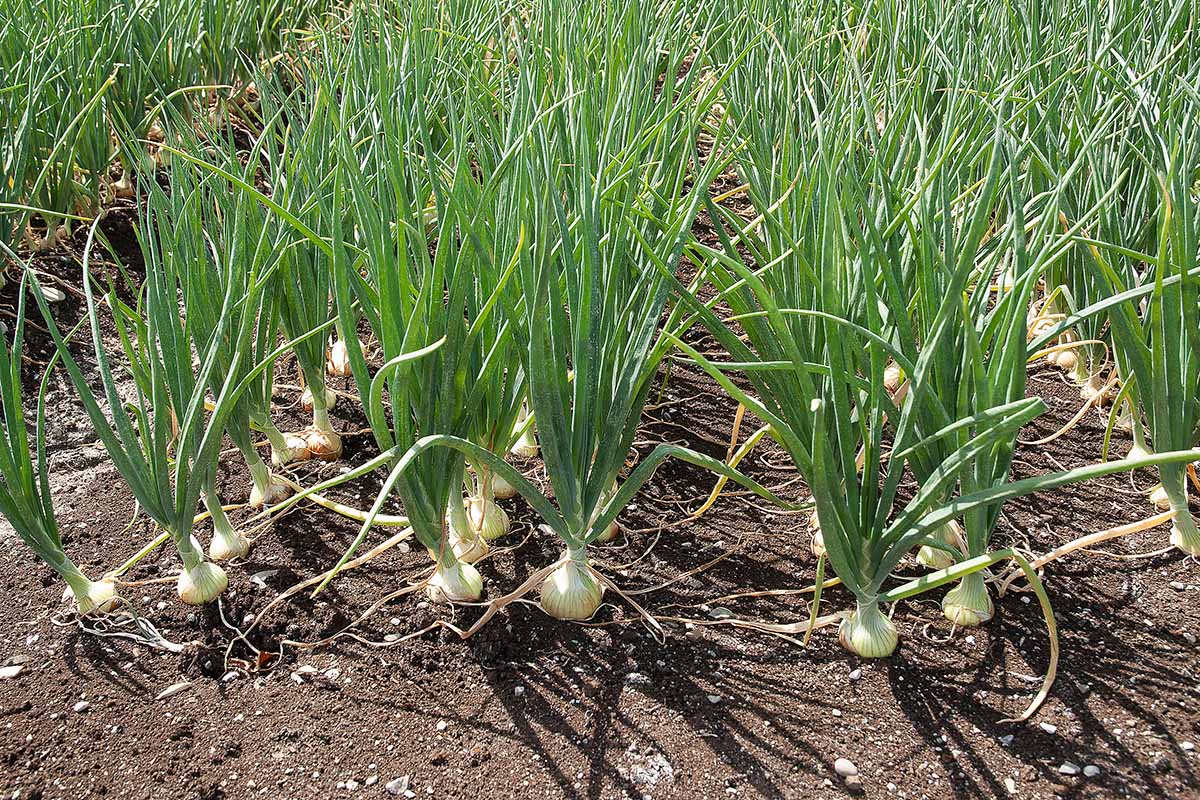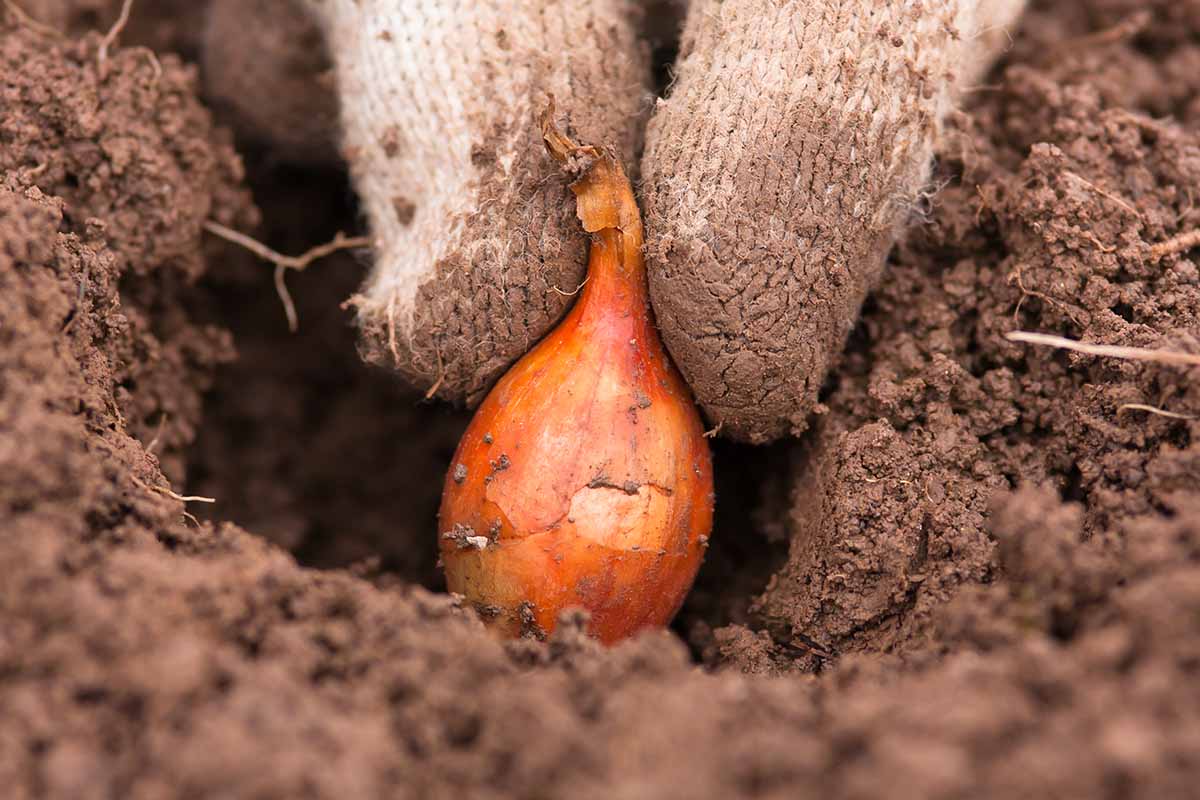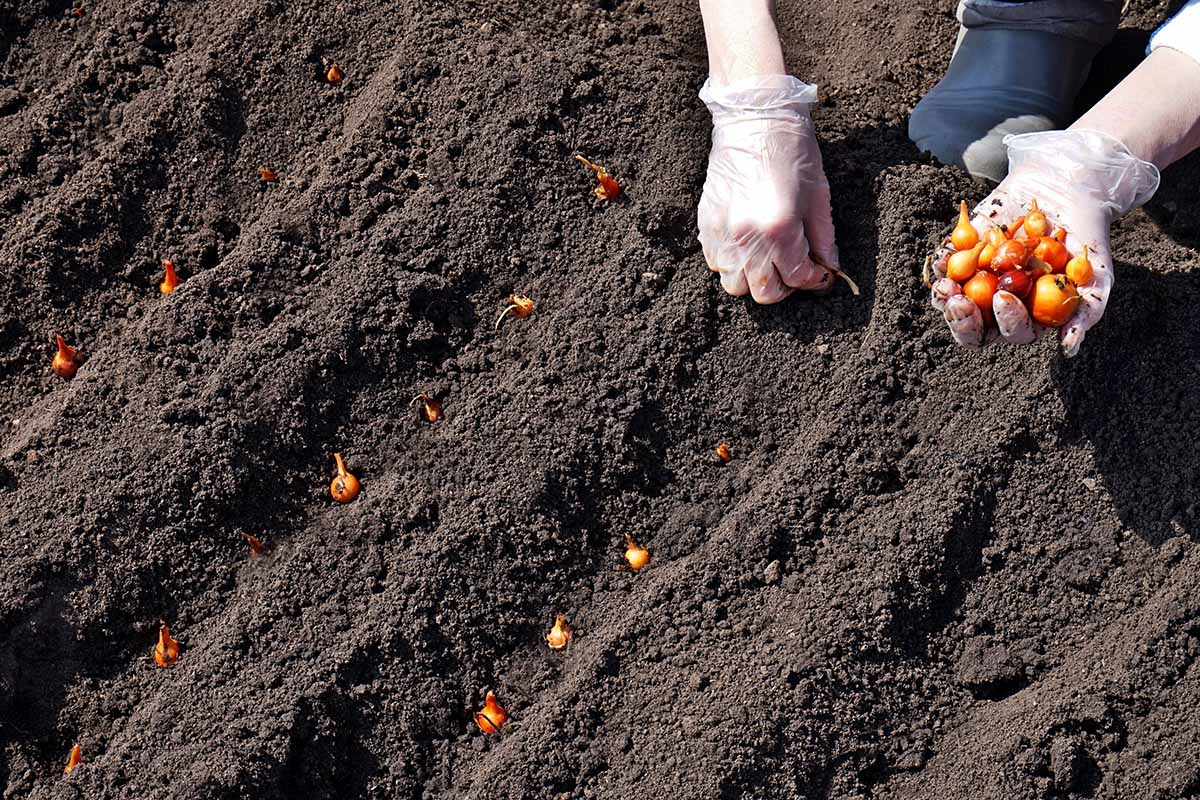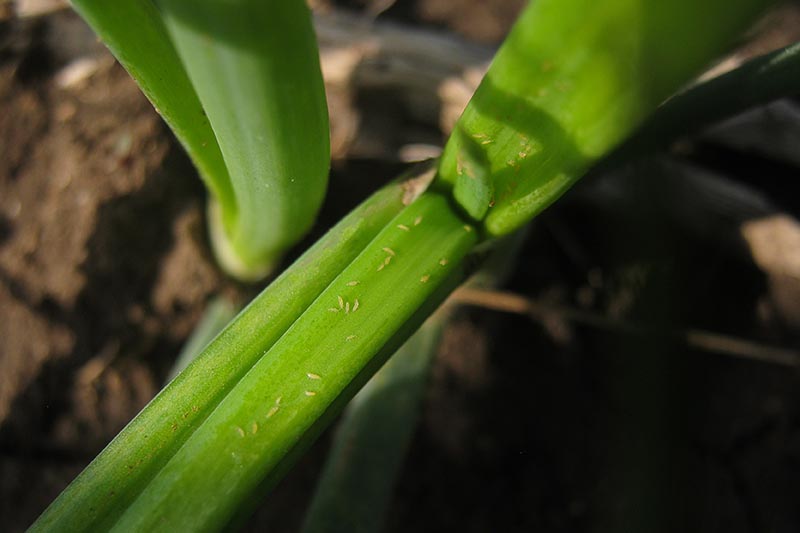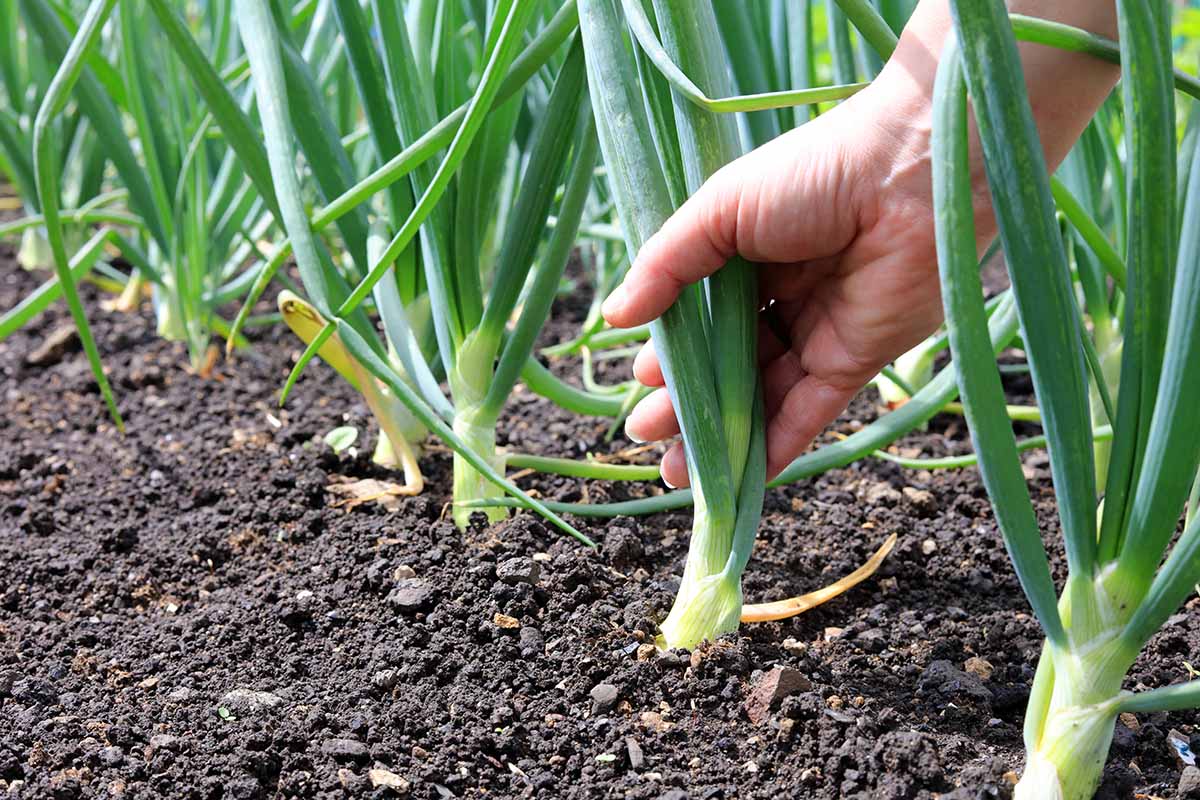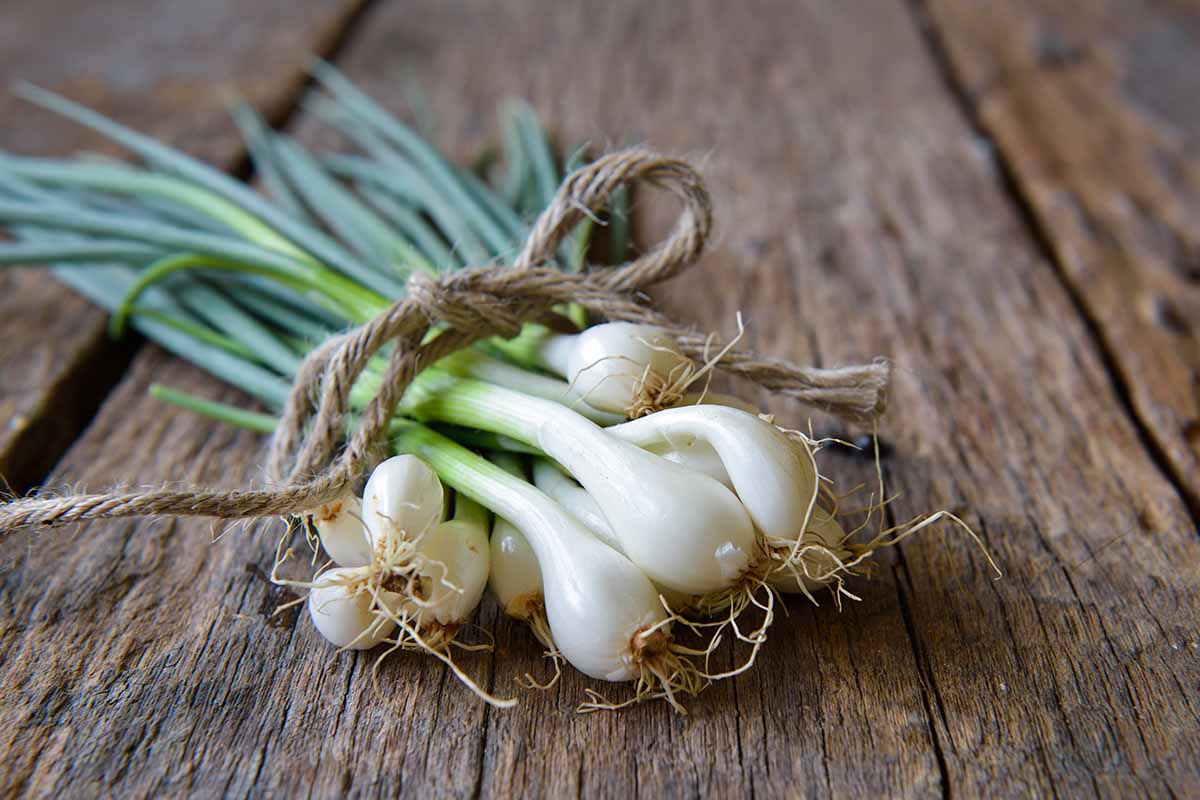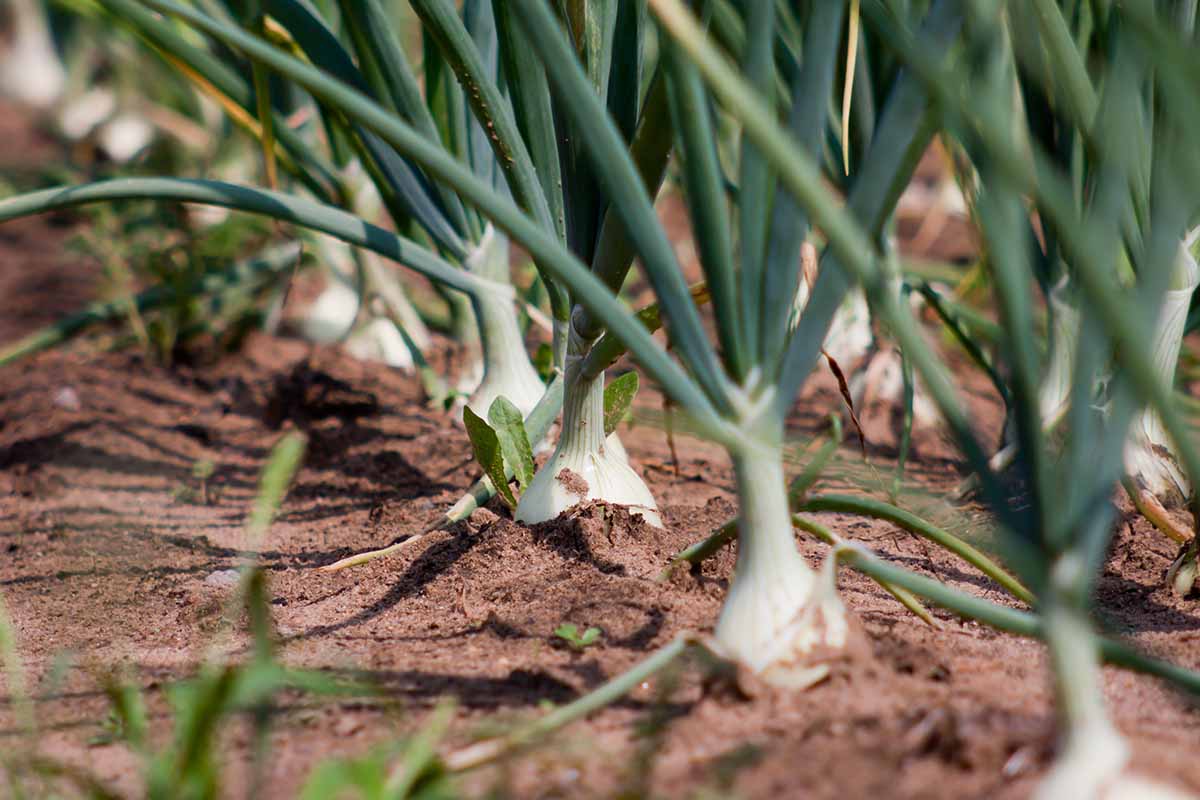Spring onions, Allium cepa, are easy to grow and care for in your garden, whether you sow seeds the fall before for overwintering, or plant in spring from seeds, slips, or sets as soon as the ground can be worked. We link to vendors to help you find relevant products. If you buy from one of our links, we may earn a commission. Eaten raw, spring onions have just the right amount of fresh, savory, allium flavor for salads, nachos, or garnishes. Both the hollow green tops and the white, red, or yellow portions of the young bulbs also add extra zip and nutrition to cooked recipes that include frittata, stews, and onion jam. Before you plant your own crop, it’s important to distinguish between this delectable harvest of immature bulbing onions and scallions or bunching onions. We’ll go over that distinction together, and then move along to the best techniques for growing spring onions at home. If you’ve never had the pleasure, it may surprise you to learn how quickly and easily this homegrown veggie goes from planting seeds or sets to an early-season cool-weather harvest. Here’s what we’ll cover:
What Are Spring Onions?
There’s a lot of delicious confusion about the name “spring onion.” Many people use the phrase to describe scallions, but these are actually perennial alliums that spread by bunching and never form full-sized bulbs. The vegetables that are commonly referred to as “spring onions” in the way that we’re covering here, on the other hand, do produce large bulbs. They are harvested to eat quickly after picking, without curing, and without the expectation that they’ll last in storage for more than a week or so. Though they are technically storage types, the same as the bulbs we’re all familiar with from the grocery store or our long-term gardening efforts, the difference here is in the way they’re grown and when you pull them. While it can take as long as 120 days from sowing to harvest mature bulbing onions that are ready for curing, you pull spring onions while they’re immature, and before they’ve formed skins to protect them in storage. They’re generally more pungent than scallions, and not as sweet as the A. cepa bulbing varieties grown to maturity. You can also eat the spring onion’s outer layer, unlike the papery brown outer skins that you’ll see on storage onions. The main advantage of growing bulbing onions to harvest in spring is the speed with which you can achieve this. And it sure is nice to have a homegrown vegetable that’s ready to eat fresh and cook with when the weather’s still cool, early in the season. If that sounds good to you, let’s get growing!
Propagation
There are several options for starting spring onions, each with its own advantages.
From Seed
To plant seeds outdoors, prepare the soil by cultivating it to at least eight inches deep. Sow spring-planted seeds as soon as you can work the ground. Just check the forecast first, and don’t plant if nighttime temperatures are expected to drop below 20°F. Space the seeds about four inches apart, pressing them lightly into the soil and covering them with a quarter-inch of sifted compost or light soil. Firm the soil with the heels of your hands, and water the seeds in well. You can also start seeds indoors to transplant out. To learn more about sowing vegetable seeds outdoors, refer to this guide.
From Sets
Onion sets are tiny, dormant bulbs. They have already been sown from seed, harvested as young bulbs, and then dried. These stay dormant until you plant them, usually around six to eight weeks before the last frost date in your area. Sets are the fastest option to grow spring onions, yielding a harvest a few weeks after planting. Of course, sets are a bit more expensive than slips and cost far more than seeds. There aren’t nearly as many options available to you as when you purchase seeds, either. But the speedy harvest can justify the extra expenditure, especially when you compare the price of growing them from sets to buying a similar product from the grocery store or a farmers market. And can you put a price on being able to walk into the garden just weeks after planting to pull a fresh, savory vegetable minutes before chopping it to toss into a salad or light soup? Space sets four to six inches apart. Plant them two inches deep in a long furrow or individual holes. The pointed side, which may already be showing a bit of green, faces up. Cover them with fine soil and tamp it with the heel of your hand, being careful not to damage the bulbs. Water them in, but don’t let the soil get too soggy. Keep the soil moist but don’t let the bulbs sit in water puddles or they’ll rot. They may take just a few days to sprout, or up to a week. For more tips on onion propagation, reference our comprehensive growing guide.
Transplanting Slips
You may want to get a head start by transplanting live “slips,” which are thin, wispy seedlings measuring a couple inches long. You can find them online or at local nurseries, usually sold in packets of 50 to 100. They aren’t as viable as dormant bulb sets. In my experience, nearly 100 percent of sets grow after transplanting, but more like 75 percent of slips survive transplant. But slips do give you a harvest weeks earlier than planting from seed, and they tend to cost less than sets. Transplant slips that you purchased or those you grew yourself from seeds started indoors in rows or groups in well-worked soil, spacing them four inches apart. Planting time will depend on your growing area and the length of the season. Some gardeners also choose to plant theirs out in cold frames. Place each one about three-quarters of an inch deep in furrows that you’ve dug, with the root end pointing down in the soil. Gently backfill with fine soil, firming it at the soil line, and then water deeply.
How to Grow
Even though they won’t be allowed to grow to maturity, A. cepa plants need the same friable, well-draining soil as larger bulbing onions. Also work in plenty of composted manure or other organic matter, and plant them only in slightly acidic to neutral soil with the ideal pH, somewhere between 6.0 and 7.0. Choose a sunny location, one that receives at least six hours of sun per day. Remove any rocks or lumps from the soil and rake it smooth ahead of planting. If you’re planting in the fall or late summer for an early spring harvest, put the seeds or sets in the ground a month or two ahead of your first average frost date. Consult our guide to growing winter onions for more information. Once the seeds have germinated or the sets or transplants have sprouted, there’s not a lot of maintenance involved. You will want to mulch the plants once they reach a couple of inches tall, setting down a two-inch layer of herbicide-free straw, grass clippings, or dry leaves. This will help keep moisture in and weeds out. You’ll also want to provide supplemental water to keep the soil moist – but not waterlogged – throughout the growing season. Aim to provide an inch of water per week any time the plants don’t receive sufficient rain.
Growing Tips
Plant in well-draining soil amended with plenty of organic matter.Give plants an inch of supplemental water per week when rain isn’t sufficient.When the tops are a few inches tall, mulch with a few inches of herbicide-free grass clippings, pine straw, or shredded leaves.
Pests
One nice thing about growing these alliums is that herbivores like deer and rabbits tend to leave them alone. Onion Collection If you can’t decide on a particular cultivar, why not check out this collection of onion sets, featuring red, white, and yellow types? Packets of 300 sets are available from Burpee.
Managing Pests and Disease
Onions are far more appealing to human diners than insect pests, and they aren’t particularly vulnerable to disease either. Here’s what to watch for: There are just a few insects that might attack your crop, but the threat is minimized since they’re harvested ahead of the warm weather when many pests typically proliferate. Here are four to watch for:
Allium Leafminers
Allium leafminers, Phytomyza gymnostoma, wreak havoc on many edible members of the allium genus, including garlic, chives, and, yes – spring onions. They’re tiny flies, just an eighth of an inch long. The pupae can overwinter in the stems, bulbs, or soil, so these leaf miners pose a threat on those planted in late summer or fall for a spring harvest. The larvae tunnel through leaves until they reach the stems, and the adults suck sap from the leaves, creating those telltale white trails. Use row covers to prevent these leaf miners from gaining a stronghold. And turn to our guide to learn more ways to detect, treat, and prevent allium leaf miner infestations.
Onion Maggots
Can you say, “yuck”? Onion maggots (Delia antiqua) grow to about a centimeter long. Their pupae overwinter in the soil and then emerge in the spring as gray-brown flies. The adults in turn lay eggs on allium leaves, and the larvae that hatch chomp down on all parts of A. cepa: roots, bulbs, and tops. The maggots also create wounds that allow soft rot pathogens entry into the plant. Root maggots present the biggest threat when spring weather is cold and wet – which is typical early in the season. If you’ve noticed wilting on newly emerged plants, D. antiqua could be the culprit. An integrated pest management strategy can help to prevent these root maggots from getting established in seedlings and bulbs. Learn more about detecting and controlling root maggots in our guide.
Slugs
These gastropods are active at night, and they may chew up scapes in the early spring. This can slow down the plants’ growth, render the tops inedible, and eventually kill whole plants. It’s fairly straightforward to eliminate or at least deter slugs before they do substantial damage, though, with methods including hand-picking the culprits or employing diatomaceous earth. Learn more techniques for coping with slugs in the home garden in our guide.
Thrips
Thrips are tiny winged insects that are part of the Thysanoptera family. They thrive in warm weather, damaging and killing plants by sucking sap from the foliage. They’re not much danger to spring onions growing in cool weather, unless you started seeds early, the summer before. Thrips have this nasty habit of overwintering and then the nymphs come out in full force in early spring. You can recognize their presence if you spot white or silvery spots on the green tops. If you can catch them early, you can usually deter them with neem oil or insecticidal soap. Just remember that a few will become thousands once the weather gets warmer. Learn more about detecting and preventing thrips in our guide.
Diseases
These plants are relatively disease-free, but several species of Botrytis fungi may attack them. The resulting disease can cause neck rot or sunken spots on the immature bulbs. It can also make the leaves wilt, which slows the growth of the plant and keeps the young bulbs from developing. Prevention is key to stave off botrytis. It thrives in soggy conditions, so well-draining soil is a must. If you detect symptoms of this fungal disease, it sounds ruthless, but you’ll need to pull all of the affected plants and destroy them. Otherwise, the fungus can spread quite quickly. Also consider applying a fungicide to the remaining unaffected A. cepa plants.
Harvesting
You’ll have lots of swell harvest options for this homegrown veggie, depending on when you planted and what type of onions you enjoy most. To start, once the tops are at least four inches tall, you can clip a few of the greens to use as a flavoring in your cooking, or to eat raw. If you planted from seed, the immature bulbs will be ready to pull 40 to 50 days from sowing, depending on the variety. Be sure to consult your seed packet for more information. Those who start spring onions from slips or sets can expect a viable crop in three or four weeks, and no later than 40 days after planting. For full spring onion flavor, wait until the plant is about six to eight inches tall and the main stalk is half an inch wide. If you’re pulling those grown from seeds or sets planted the previous year, they should attain the proper size shortly after the ground thaws in spring. To harvest, get a firm grip on the leaves where they meet the bulb at its “neck.” Twist a half turn, and tug upward until the white part emerges from the soil. If they’re growing in compacted soil, you may need a trowel or spade to loosen the roots before pulling. A few more notes on the harvest process: If your plants start forming buds and flowers – or bolting, in other words – pull them immediately to retain the best flavor. If you’re planning to leave a few bulbs in the ground to reach full maturity as storage onions, be sure to replace the dirt you disturbed while harvesting the immature bulbs growing nearby. Gaps in the soil can collect moisture that will harm the remaining bulbs. And if you don’t like a pronounced oniony flavor, be sure to pull your crop before it reaches full maturity. Older roots will be extra pungent.
Storage and Preserving
There are plenty of varieties of homegrown onions you can grow and cure to store for months, but those picked early are best suited to fresh enjoyment. Try to only pull as many as you can use quickly. You can keep extras in an open zip-top bag in the fridge wrapped in a damp paper towel, but only for a week or so. Don’t use any of the greens that turn yellow, wilt, or have soft spots. If you end up with more than you can eat straight from the garden, fear not. There are plenty of ways to preserve spring onions too. The first is simplest: Chop them, freeze them on a baking sheet, and then place the frozen pieces into an airtight container in the freezer, where they’ll keep for about six months. You can add the frozen pieces to stews and stir fries, or thaw them overnight in the fridge. But keep in mind that these are best for cooking, and they won’t maintain their crisp texture for use in salads or garnishes after thawing. You can also dehydrate the chopped tops or diced bulbs, using a dehydrator or oven set to 125°F – no blanching required. A crisp, dry texture indicates they’re ready. Thin rings of the bulbs are also delicious in pickle recipes. Our sister site, Foodal features a recipe for zucchini bread and butter pickles, and while it calls for a small, sweet, mature onions, spring-harvested onion bulbs will work here, too.
Recipes and Cooking Ideas
Along with being easy to grow and one of the first vegetables you can harvest in cool weather, these immature A. cepa bulbs have a range of uses for fresh eating and in cooking. You can use a few slices here, or a spoonful of chopped greens there, to enliven a wide variety of dishes from salads to scrambled eggs. One of my favorite rites of spring involves mincing a young bulb to add to a light vinaigrette, and tossing it with fresh-picked mesclun, and then garnishing the salad with some of the greens. If you end up with an abundant harvest, you’ll have enough of the bulbs on hand to cook more substantial dishes, like this German onion tart from our sister site, Foodal. Just keep in mind that it’s best to cut off the green tops and use them for another purpose as you would with scallions or garlic scapes, since they don’t caramelize the way the bulbs do. You could also swap the white or yellow portion of the immature bulbs for full-size storage onions in chowders and soups like Foodal’s farmers market-inspired curried corn and cabbage soup, or this recipe for chicken split pea soup. Make the same substitute in stir fries. Or give spring onions a try as a seasonal ingredient in Foodal’s recipe for easy chicken fajitas, and don’t forget to save the tops for a garnish. Speaking of the greens, you can use them interchangeably with scallions, or even chives. They do tend to be a bit more pungent than those other alliums, but they’ll pep up many different dishes from baked potatoes with sour cream or steamed green beans to simple weeknight meals like 15-minute sesame noodles. Get the recipe for these from Foodal. As the season warms up, grill the fresh harvest for a piquant side dish. Start by cutting off the roots and the tips, trimming them so you’ll have sections about four or five inches long. Brush them lightly with olive oil and grill for five minutes per side on a medium-hot grill. They should start to soften and the white part should begin to caramelize, but don’t let them cook so long that they get mushy. Season them to taste and spritz with balsamic vinegar or fresh lemon juice before serving warm or at room temperature. You can chop leftovers to use in sandwiches, meatloaf mix, or as a pizza topping. I hope you enjoy the experience! If you have questions or success stories to share, the comments section below awaits your input. And if you’re interested, there is lots more info about onion growing in these guides for you to read next:
How to Grow and Harvest Bunching Onions15 of the Best Onion Varieties to Grow at Home
